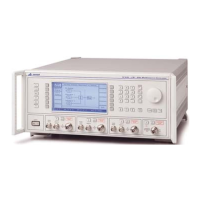GENERAL INFORMATION
46882/439 1-7
ΦM on AM:
Typically 0.1 radian at 30% depth at 470 MHz.
*For RF levels not exceeding +10 dBm (individual output) or −4 dBm (combined output).
Pulse modulation
Carrier frequency range: 32 MHz to 2.4 GHz, usable to 10 MHz.
RF level range: Maximum guaranteed output is reduced by 5 dB when pulse
modulation is selected.
RF level accuracy: When pulse modulation is enabled, adds ±0.5 dB to the RF level
accuracy specification.
Control:
Front-panel BNC connector with an input impedance of 10 k Ω nominal.
A logical ‘1’ (3.5 to 5 V) turns the carrier on, a logical ‘0’ (0 to 1 V)
turns the carrier off. Maximum input is ±15 V.
On-off ratio:
Better than 45 dB below 1.2 GHz, better than 40 dB above 1.2 GHz.
Rise and fall time:
Less than 10 μs.
Overshoot: Less than 1 dB
Modulation oscillator
The internal modulation oscillator for each signal source is capable of
generating one or two modulation tones simultaneously in one
modulation channel.
Frequency range: 0.01 Hz to 20 kHz with a resolution of 0.01 Hz.
Frequency accuracy: As frequency standard.
Distortion: Less than 0.1% THD at 1 kHz.
Waveforms: Sine to 20 kHz, triangle or square wave to 3 kHz.
Square wave jitter:
Less than 6.4 μs on any edge.
Audio output: The modulation oscillator signal from each source is available from
the modulation input/output BNC connector at a nominal level of
2 V RMS EMF from a 600 Ω source impedance.
External modulation
A front-panel external modulation input/output BNC connector is
provided.
Input level: 1 V RMS (1.414 V peak) sine wave for set deviation. Maximum safe
input is ±15 V.
Input impedance:
100 kΩ nominal.
Modulation ALC: Levels the applied external modulation over the range 0.75 to 1.25 V
RMS sine wave. High and low indicators in display indicate when the
input is outside leveling range.
Sweep mode:
The carrier frequency of one source can be swept. To enable more
than one source to be swept the coupling facility must be invoked.
Control parameters:
Start/stop values of carrier frequency, frequency step size and time
per step.
Step time:
50 ms to 10 s per step.
Trigger:
A trigger input is available on a rear-panel BNC connector and can
be used in single, continuous, start/stop or single-step mode.
Frequency standard
TCXO: 10 MHz.
Temperature stability: Better than ±5 in 10
7
over the operating range 0 to 55°C.
Aging rate: Less than ±1 in 10
6
per year.
External input/output: Rear-panel BNC connector accepts an input of 1 MHz or 10 MHz at
220 mV RMS to 1.8 V RMS into 1 kΩ.
Rear-panel BNC connector provides an output of 10 MHz at a
nominal level of 2 V pk-pk into 50 Ω.
Remote control
GPIB interface
All signal source parameters except the supply switch are remotely
programmable.
Capabilities:
Designed in accordance with IEEE 488.2.
Complies with the following subsets as defined in IEEE Std 488.1:
SH1, AH1, T6, L4, SR1, RL1, PP0, DC1, DT1, C0, E2.

